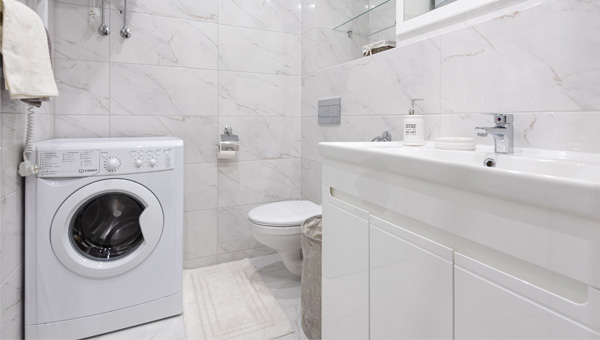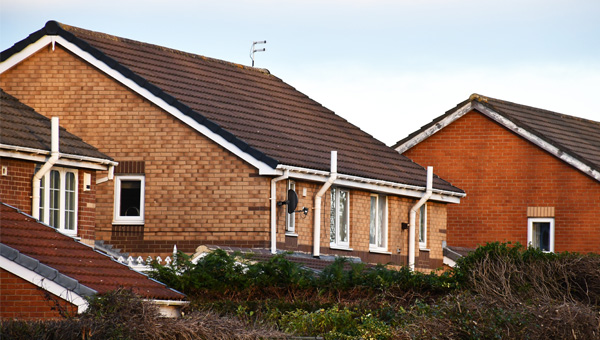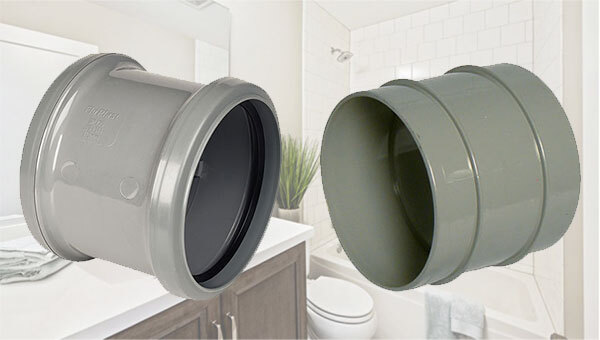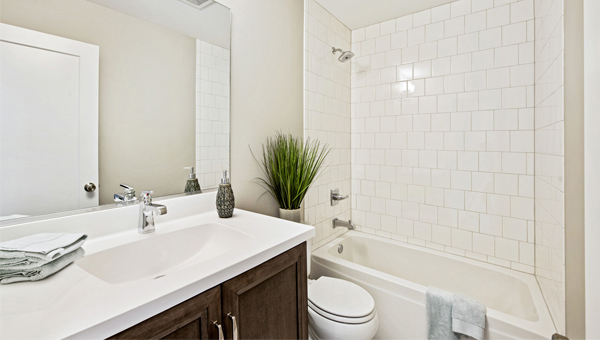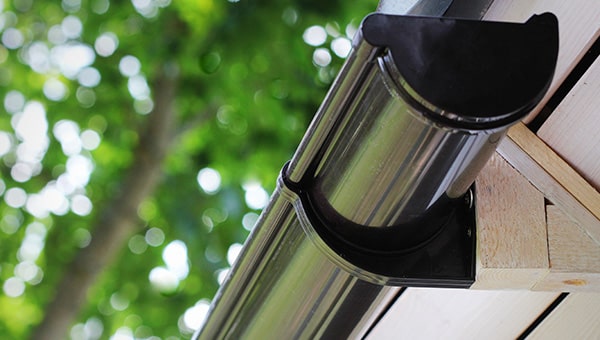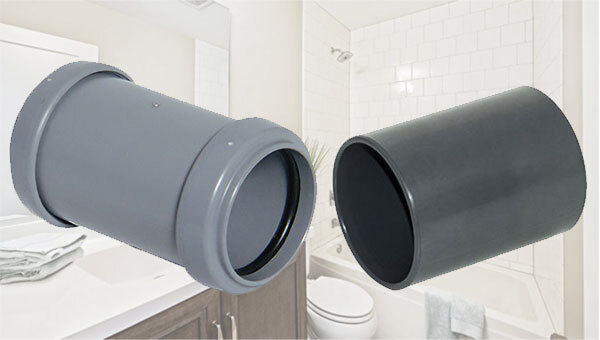 Waste pipes have the unenviable job of carrying away all the wastewater we create in our day to day lives. They are one of the most essential systems within our homes, and yet many of us never give them a second thought. But what if something goes wrong, or you want to add or replace a sink, bathtub, or washing machine? That's when knowing the basics can really help.
Waste pipes have the unenviable job of carrying away all the wastewater we create in our day to day lives. They are one of the most essential systems within our homes, and yet many of us never give them a second thought. But what if something goes wrong, or you want to add or replace a sink, bathtub, or washing machine? That's when knowing the basics can really help.
In this article, we're going to concentrate on what you need to know for expanding your existing system or installing an entirely new one. Before we get started, though, let's make sure we're all on the same page by asking a simple question.
What is a Waste System?
A Waste System is a network of pipes and fittings (usually 32, 40, or 50mm in diameter) that run through your property, connecting any sinks, bathtubs, showers, dishwashers, or washing machines to the main drain. These pipes ensure that the dirty water produced in our kitchens and bathrooms is transported safely away into the sewer or an off-mains treatment/storage tank if you have one.
It is not to be confused with a Soil System, however, which is made up of larger diameter pipes designed to handle water and bodily waste from toilets, urinals, and bidets. Even though the two systems can often be connected together, they do have very different requirements. For advice on soil systems, check out our other article, "Ring Seal or Solvent Weld - which soil pipe system is better?". If you would like more information about soil and waste systems in general, take a look at our "Basic Guide to Soil & Waste Systems".
Confident we're talking about the right system? Great! Then let's take a deeper dive into what types of waste systems are available.
What type of waste systems are there?
If you are looking to replace or upgrade your existing waste system, the first thing you should consider is the type of material you want it to be made from and also the type of material it will be connecting to.
Traditionally, the material of choice for waste systems was copper (though lead and iron were also not uncommon once upon a time), and these pipes can still be found in most properties built before the 1950s. Even today, copper pipes are still a popular choice among professionals who favour the aesthetic appeal that copper can give to an installation. However, while these pipes do have a number of benefits, including being easier to fit into tight spaces, there are two significant disadvantages to using copper in the construction of your waste system that can be off-putting to many of us. The first is the fact that installing an entire copper system can be both difficult and time-consuming due to the need for joints and connections to be soldered together. The second disadvantage to copper is that it can be a much more expensive material to work with in comparison to its more modern alternative...namely, plastic.
Plastic pipes have fast become an industry standard for soil, waste, and drinking water installations in modern homes. They are resistant to corrosion and impact damage, lightweight and easy to install, and are much less expensive than their metal counterparts. For both building professionals and DIY enthusiasts alike, we feel that plastic waste systems offer an ideal modern-day solution that is more accessible and cost-effective than other materials - hence why we stock the range that we do.
However, when it comes to plastic waste pipes, there is an additional choice to be made—the choice between Push-Fit or Solvent Weld connections. For our range of Floplast waste pipes, this also means choosing Polypropylene (for push-fit) or ABS (for solvent weld) plastic. Both types of plastic make for quality waste systems, but they do have advantages over each other in certain situations, which we will discuss later. For now, let us focus on the differences between the two connection types.
What is a Push-Fit waste connection?
A waste system consisting of push-fit connections doesn't need any sealant or glue to form its joints, as it relies instead on rubber rings to create watertight seals. Standard pipe lengths in this style come plain ended, with chamfered edges to aid the ease of jointing, for connection to fittings with socketed ends, which house the rubber ring seal. As the name would suggest, that connection is made by simply pushing the plain end of a pipe into the socketed end of a fitting. The chamfered edge allows the plain end to slide into the socket, with the help of some silicone lubricant, without dislodging the rubber ring, which then creates a tight seal around the pipe. The greatest benefit of this jointing method is that, since no sealant or glue has been used, it can easily be pulled apart and reconnected as needed. This makes both installing a new system and replacing damaged or worn out sections much easier to do than with permanent jointing methods.
What is a Solvent Weld waste connection?
A waste system consisting of solvent weld connections is made up of pipes and fittings that are permanently joined together by a chemical bonding process. Standard pipe lengths in this style also come plain ended, but the edges are cut straight to create a better connection to compatible socketed fittings. Without a rubber ring seal in these sockets, the connection is made instead with solvent cement, applied both inside the socket and around the plain end of the pipe, which welds the two together. The chemical reaction caused by the cement basically melts the surface of the plastic. When this happens to both surfaces in the joint, it causes them to bond together and then set into, effectively, one solid piece of plastic. This forms a much stronger joint that is both gas and watertight, but it is a permanent one that cannot be pulled apart to realign or correct a mistake.
Which Waste Pipe System is best?
As mentioned earlier, the range of waste systems we stock consists of either Polypropylene Push-Fit or ABS Solvent Weld pipes and fittings. Both materials and connection types are perfectly suitable for creating strong, durable, and reliable waste pipe systems, but there are some pros and cons to each that are worth reviewing to ensure you make the best choice for your project.
Pros that they share:- They are both manufactured to the same standards.
- Can withstand high-temperature liquids (up to 76 degrees as standard and up to 100 degrees for intervals of no more than two minutes).
- Are resistant to most inorganic acids.
- If used externally, they should both ideally be given a coat of paint to protect them from U.V. rays.
Please Note: Some manufacturers may advise that their ABS waste pipe can be used externally without needing any U.V. protection. The manufacturer of our waste pipes, Floplast, states that their ABS pipes should be painted when used outdoors. Our recommendation is to either always follow the guidance given by the manufacturer of your chosen products or, if in doubt, give the pipes a protective coat of paint to be on the safe side.
The differences between these two material types mainly come down to the permanence of the joints and ease of assembly.
| System Comparison | ||
|---|---|---|
| Pros | Cons | |
| Polypropylene Push-Fit | Simple, flexible jointing method. | Prone to leaks if not installed correctly. |
| Quick and easy to install. | Ring seals can degrade over time and need replacing. | |
| Can easily be separated. | Joints require more support to prevent stress on the seals. | |
| System can be used immediately after install. | ||
| Pros | Cons | |
| ABS Solvent Weld | Strong, permanent jointing method. | Takes longer to install. |
| More impact resistant. | Can't be separated once weld is set. | |
| Joints are less likely to leak. | Should be left to set for 24hrs before fully testing. | |
| Generally more expensive than Polypropylene Push-Fit systems. | ||
So which one is best for you? Well, the answer to that will broadly come down to personal choice. Solvent weld systems are sometimes favoured in areas where there is a higher risk of impact damage, such as on an external wall or in public buildings, due to the rigid joints being more robust. That being said, a solvent weld system, on the whole, is far less flexible than a push-fit one and more difficult and time-consuming to repair.
Push-fit systems are cheaper, easier to work with, and quicker to install, making them an ideal choice for DIY projects. For this reason, we'd lean more towards recommending our Polypropylene Push-Fit waste products to any novice "have-a-go" plumbers out there, as they are much more forgiving of mistakes when it comes to connecting up a system.
But what if you already have an existing solvent weld system? What if your house has existing copper pipes that you don't want to replace? Can you install a new sink or repair an existing connection with push-fit products if you don't have a full push-fit system? Well, there we have some good news.
Can Push-Fit and Solvent Weld waste systems be mixed?
Essentially, yes, but it is very important to understand the differences and that they are not primarily designed to fit each other. Since both systems have pipes and fittings available in 32mm, 40mm, and 50mm sizes, you can convert a solvent weld system to a push-fit one by using a suitable conversion fitting or universal coupler. The bigger question, however, is whether you should.
When it comes to plumbing, the simpler, tidier, and easier to manage your pipe systems are, the better. As a general rule, keeping a consistent connection type between your soil, waste, and overflow pipework makes installation, maintenance, and repair a lot easier. However, outside of new builds or large scale renovation projects, it can be challenging to adhere to this rule when doing a bit of DIY to install a new sink or replace a bathtub with a shower stall etc. If your existing pipe system uses solvent weld connections, but you feel more comfortable working with push-fit, the only thing you really need to worry about is ensuring you are using the right sized pipe for the right application (32mm for small hand basins, 40mm for all other appliances, and 50mm for commercial applications or connecting multiple waste pipes into a single flow) and that your joints are properly sealed and supported.
There is one condition to this, however, which is worth noting now to avoid connection headaches later on. While it is true that the advertised diameters of these pipes are standard between Polypropylene and ABS, the actual measurements do often differ. All drainage pipes are measured externally (i.e. the size advertised is the external diameter of the non-socketed parts of a pipe or fitting), but the sizes shown to you are intended to indicate where the pipe should be used, rather than be an exact measurement of the external diameter. When you see a pipe or fitting listed as 32, 40, or 50mm, it is done to indicate what type of waste application it is suitable for. For example, a 32mm push-fit waste pipe is suitable for connecting up a small hand basin, but the actual external diameter of the pipe could be 34mm. This isn't an issue if you are only using push-fit pipes and fittings from the same manufacturer, as they will all be designed to the same tolerances. However, it's when you need to mix the connection types that problems can often arise. It would seem logical to assume that you could connect a 32mm solvent weld system to a 32mm push-fit system simply by taking a plain ended length of pipe and joining one end to a solvent weld fitting and the other to a push-fit fitting...but we all know what happens when you start assuming things.
Put simply, this will not work, and it all comes down to differences between the Actual external pipe diameters of these pipes and fittings. The table below gives an example of this.
| Waste Pipe Diameter Comparison | ||
|---|---|---|
| Nominal Diameter | Push-Fit External Diameter | Solvent Weld External Diameter |
| 32mm | 34mm | 36mm |
| 40mm | 41mm | 43mm |
| 50mm | 54mm | 56mm |
As you can see, while there aren’t huge differences in the diameters, those extra couple of millimeters can mean all the difference between a fitting either being too loose or too small to enable a connection between the systems. The only way to securely join a push-fit and a solvent weld waste system together is to use either a conversion fitting or a universal coupler.
Universal compression fittings, like the range of Floplast Unicom fittings we stock, take all the hassle out of getting a watertight seal between pipes of different sizes though. So, if you need to join different types of waste pipes together, grab a Unicom fitting for peace of mind.
One other important thing to remember, if you are dealing with fittings that have a socketed end and a spigot (plain) end, is that the socket should always point upstream (i.e. pointing back towards the sink or washing machine etc.) so it goes against the flow of water, and the spigot should point downstream (i.e. away from the sink or washing machine etc.) so it goes with the flow of water.
Can plastic waste pipes be connected to copper or lead waste pipes?
Absolutely! Most properties built before the 1950s (when plastic pipes first started being used in the UK) will most likely still have copper waste systems (possibly lead or iron too in some cases) which work perfectly fine and don't need completely replacing. However, if repairs or additions have been made to the system in more recent years, there's a good chance it's been done with plastic pipes and fittings since they are cheaper and easier to install. Thanks again to Floplast's range of UNICOM compression fittings, connecting new plastic pipes (either Polypropylene or ABS) to these older metal pipe systems is very straightforward. The compression fittings take up any discrepancies in the size difference between the different materials and allow for a secure connection to be made.
Can plastic Push-Fit and Solvent Weld waste pipes be connected to a Cast Iron Soil Stack?
The simple answer to this is yes. Regardless of the connection type, or the material your soil stack is made from, waste pipes can be connected through the use of appropriate boss adaptors. One thing we would say to be cautious of, however, is that older cast iron pipes can still contain elements of asbestos. Therefore, should your project require you to cut into or remove parts of an existing cast iron pipe, we would strongly recommend that you consult with a professional plumber first.
Do waste pipes need to be connected to a Soil Stack?
Technically, no. Waste pipes can be connected directly to the main drain and often are in older properties. If your existing system is already set up this way and works properly, there is no need to change it. If, for whatever reason, you wanted to separate a system that currently runs into a soil stack, there will be a pressure issue that you need to be aware of.
Whenever water flows through your waste system, it carries air along with it into the pipes, which can create a negative pressure change. This, in turn, can cause the water in your appliances traps and u-bends to be siphoned out, which could then allow unpleasant odours to return up from the drains and generally impact the ability of the system to drain away waste water properly. If the waste system is connected to a soil stack, a vent pipe or air admittance valve will be in place to help keep the pressure in the system balanced. However, if the waste system doesn't run into the soil stack, it will probably need its own air admittance valve installing to prevent negative pressure build-ups. Have a read of our Soil Vent Pipes vs Air Admittance Valves article for more on this.
Once you've decided upon your preferred material type and chosen the most suitable connection type for your needs, the next step is to buy the system/products you need and get it installed. If you decide to purchase a high-quality Polypropylene Push-Fit or ABS Solvent Weld system, we've got you covered with our full range of Floplast waste pipes and fittings.
If you have any questions or need any further advice about your soil and waste systems, however, check out our Soil & Waste FAQ article or contact JDP today. Our team of experts are always on hand to help with all of your drainage needs.


